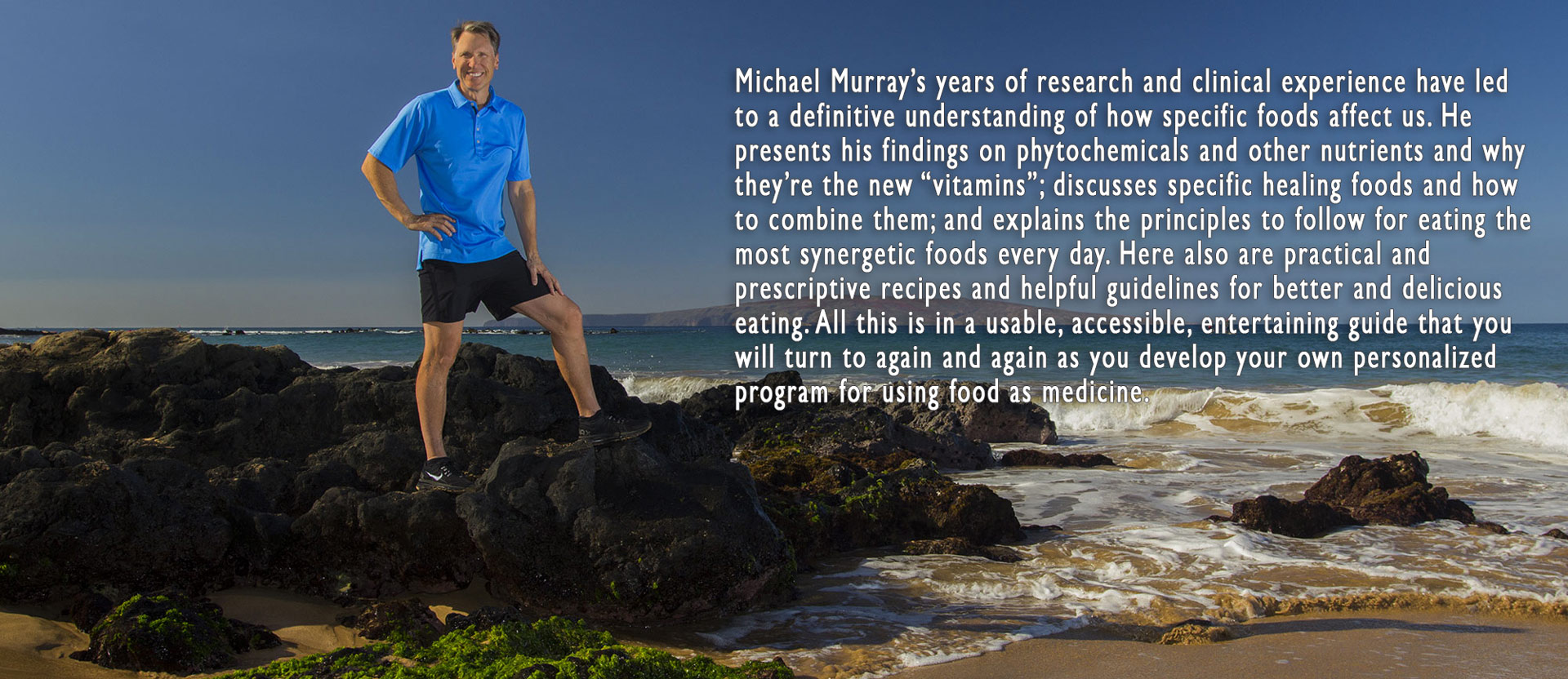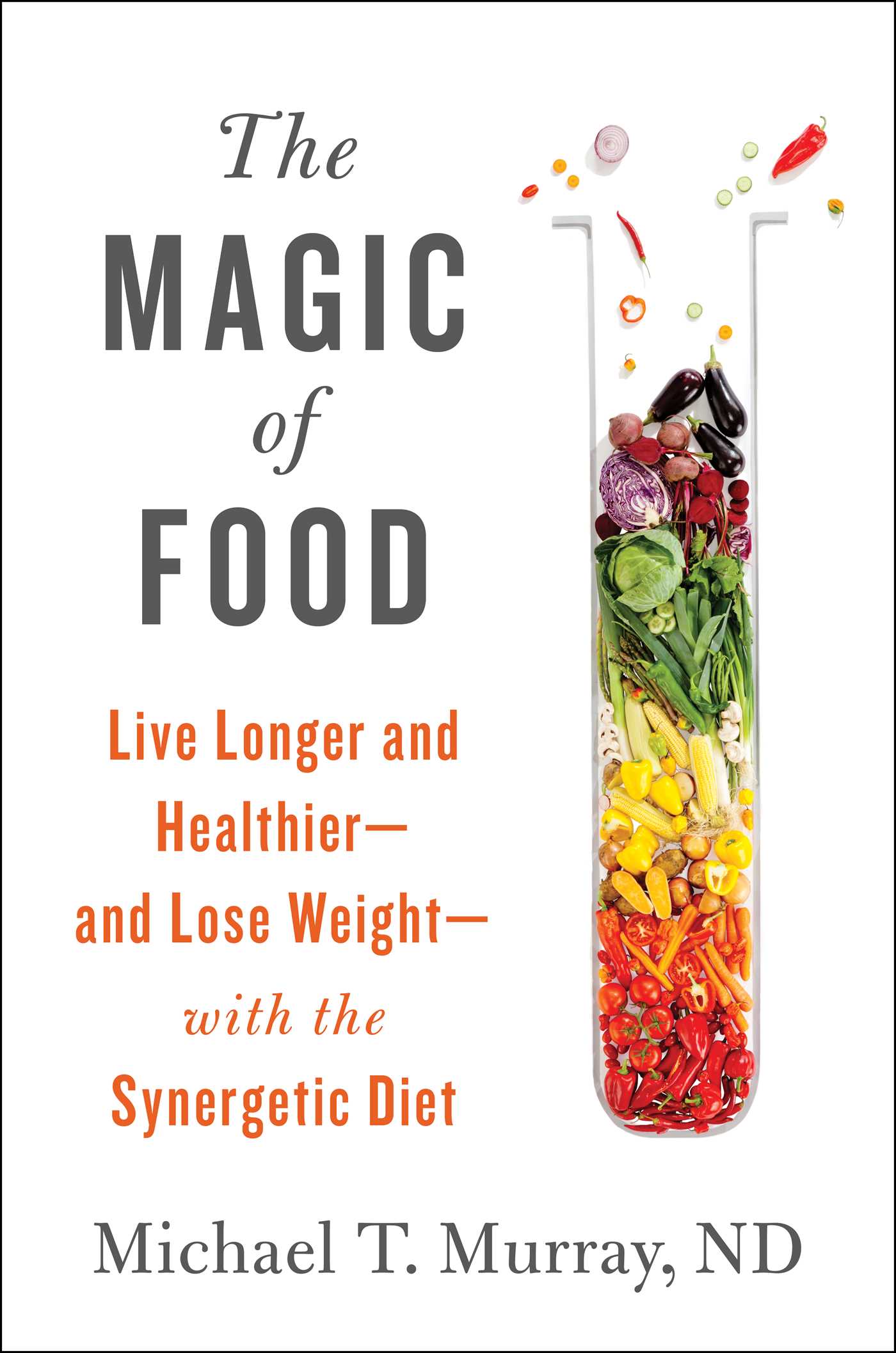
Michael Murray’s years of research and clinical experience have led to a definitive understanding of how specific foods affect us. He presents his findings on phytochemicals and other nutrients and why they’re the new “vitamins”; discusses specific healing foods and how to combine them; and explains the principles to follow for eating the most synergetic foods every day. Here also are practical and prescriptive recipes and helpful guidelines for better and delicious eating. All this is in a usable, accessible, entertaining guide that you will turn to again and again as you develop your own personalized program for using food as medicine.
Please sign up for my weekly newsletter and you will receive the preface and whole first chapter of my book for free.
Or buy it now on Amazon

320 Pages of powerful information that can and will
“Change Your Life“
Table of Contents:
1
You Are What You Eat
2
What Should We Eat for Health and Longevity?
3
AMPk: Activating the Enzyme of Youth, Longevity, and Weight Loss
4
Why Dietary Fats Are Essential
5
The Power of Plant Pigments
6
My Favorite Superfoods
7
Spice It Up!
8
The Synergetic Diet with Recipes
9
Food as Medicine
FOOD HAS ALWAYS BEEN MAGICAL TO ME
Food nourishes, heals, comforts, inspires, and brings us joy throughout our lives. There’s nothing else that has this kind of power. Even after a lifetime of studying food and nutrition, I am still awed by the inherent magic of nature and the food that she gives us. Now a new era of food awareness is emerging; people are concerned as much about healthfulness and diversity of foods as they are about flavor. Healthier foods are now being served everywhere from high-end white-tablecloth restaurants to fast-food chains, from airport concessions to mall food courts. Convenience stores and mainstream grocery stores are also improving the quality of food they stock.
With the epidemic of obesity, diabetes, cancer, and other diet-related dis- eases exploding, not just in the United States but also worldwide, improvements in the quality of food we eat cannot happen soon enough. I believe that food is going to become a primary form of medicine, even as eating good food remains one of life’s great pleasures. We will be able to tailor what we eat to our unique dietary requirements and health goals and still please our palates.
Through The Magic of Food, my goal is to stir your passion for healthful eating and inspire you to make the right choices for your well-being. I have packed The Magic of Food with sound, medically based information to lead you on a journey on which you will discover the remarkable ways in which food can have a magical, yet real, impact on your body, mind, and health.
One of the major concepts in The Magic of Food is “synergetics.” Simply put, synergetics is how different foods and dietary factors work together to achieve a positive effect greater than the sum of each individual factor. So, in this case 1 + 1 + 1 does not equal 3 but something much greater!
Excerpts from Chapter 1
Genetics, Epigenetics, and Nutrition
 The Human Genome Project (HGP), an international research project, described, or sequenced, the chemical base pairs that make up the genetic code—the DNA—found in a body’s 23 pairs of chromosomes. The “genome” of any individual (except for identical twins) is unique. HGP has provided information about how genes work together, as well as the genetic causes of some diseases. Yet, along the way, scientists realized that genetics alone do not entirely determine our health status. Other factors, including primarily the food we eat, influence the expression of genes and whether we develop certain illnesses…
The Human Genome Project (HGP), an international research project, described, or sequenced, the chemical base pairs that make up the genetic code—the DNA—found in a body’s 23 pairs of chromosomes. The “genome” of any individual (except for identical twins) is unique. HGP has provided information about how genes work together, as well as the genetic causes of some diseases. Yet, along the way, scientists realized that genetics alone do not entirely determine our health status. Other factors, including primarily the food we eat, influence the expression of genes and whether we develop certain illnesses…
Our DNA Is Not Necessarily Our Destiny
 Our genes need specific instructions on what to do, how to do it, and when. It’s amazing that a human liver cell contains the same DNA as a brain cell, yet somehow it knows to replicate itself into a liver cell. If these instructions are not found in our DNA, where do they come from? Scientists have discovered an array of chemical markers and switches along the length of the double helix of DNA. Collectively these factors are referred to as the “epigenome.” Think of the DNA as a computer while the epigenome is the software. The hardware is important. The software is what actually tells the DNA what to do…
Our genes need specific instructions on what to do, how to do it, and when. It’s amazing that a human liver cell contains the same DNA as a brain cell, yet somehow it knows to replicate itself into a liver cell. If these instructions are not found in our DNA, where do they come from? Scientists have discovered an array of chemical markers and switches along the length of the double helix of DNA. Collectively these factors are referred to as the “epigenome.” Think of the DNA as a computer while the epigenome is the software. The hardware is important. The software is what actually tells the DNA what to do… Good Nutrition Lowers the Risk of Genetic Disease Expression
 In 2000, a landmark study done at Duke University explored the impact of nutrition and epigenetics. The researchers started with pairs of fat mice with yellow fur that carried the agouti gene, which made them fat and yellow and also dramatically increased their risk of developing cancer and diabetes. The goal was to see if that unfortunate genetic legacy could be changed. Before the mice were conceived, a test group of mother mice was fed a diet rich in compounds collectively called methyl donors, which included vitamin B12, folic acid, and S-adenosylmethionine (SAMe). The baby mice were born brown and slender and, as they matured, did not succumb to cancer and diabetes. The nutritional intervention had completely erased the cancerous, diabetic genetic destiny of the agouti mice. Although the brown mice had the same genome as the yellow mice, the expression of the genome was significantly different because of nutritional factors. This is another instance of the magic of food and proof that genetic tendencies can be changed with dietary and nutritional approaches…
In 2000, a landmark study done at Duke University explored the impact of nutrition and epigenetics. The researchers started with pairs of fat mice with yellow fur that carried the agouti gene, which made them fat and yellow and also dramatically increased their risk of developing cancer and diabetes. The goal was to see if that unfortunate genetic legacy could be changed. Before the mice were conceived, a test group of mother mice was fed a diet rich in compounds collectively called methyl donors, which included vitamin B12, folic acid, and S-adenosylmethionine (SAMe). The baby mice were born brown and slender and, as they matured, did not succumb to cancer and diabetes. The nutritional intervention had completely erased the cancerous, diabetic genetic destiny of the agouti mice. Although the brown mice had the same genome as the yellow mice, the expression of the genome was significantly different because of nutritional factors. This is another instance of the magic of food and proof that genetic tendencies can be changed with dietary and nutritional approaches…
Diet Affects Epigenetic Factors in the Development of Alzheimer’s Disease
 Western dietary patterns—eating lots of sugar, carbohydrates, and the wrong type of fats—contribute to the development of chronic degenerative diseases. Let’s take a look at just one disease—Alzheimer’s. Many people have had someone close to them develop this degenerative brain disorder with its progressive deterioration of memory and cognition. In the United States, it is now estimated to affect about 20% of individuals between 75 and 84 and 42% of people older than age 85. These numbers are striking when compared to data from the 1960s, when the incidence was only 2% in people over the age of 85. The tremendous increase in AD in people over 85 years of age is often referred to as the “Alzheimer’s epidemic.”…
Western dietary patterns—eating lots of sugar, carbohydrates, and the wrong type of fats—contribute to the development of chronic degenerative diseases. Let’s take a look at just one disease—Alzheimer’s. Many people have had someone close to them develop this degenerative brain disorder with its progressive deterioration of memory and cognition. In the United States, it is now estimated to affect about 20% of individuals between 75 and 84 and 42% of people older than age 85. These numbers are striking when compared to data from the 1960s, when the incidence was only 2% in people over the age of 85. The tremendous increase in AD in people over 85 years of age is often referred to as the “Alzheimer’s epidemic.”…

